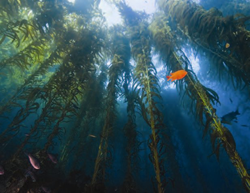United Nations member countries reached an agreement March 4 known as the High Seas Treaty, which aims to promote accountability for the protection of marine wildlife and biodiversity in international waters, following nearly 36 straight hours of negotiations.
At the conference, Rebecca Helm, a marine biologist who studies jellyfish and other coastal species with the Georgetown University Earth Commons Institute, provided delegates with expertise on marine genetic resources and insight on the potential environmental impacts of treaty propositions to help assess their practicality.

“Up until this treaty, the animals and the ecosystems that I study really didn’t have meaningful environmental protection,” Helm said in an interview with The Hoya.
The landmark agreement resolves nearly a decade of negotiations over the plan’s funding and fishing limitations, and it includes a number of provisions to conserve marine ecosystems.
The treaty’s name is derived from the last international agreement governing international waters, the 1982 U.N. Convention on the Law of the Sea. Forty years ago, the U.N. agreed upon a shared ownership system of the “high seas” — waters where countries can openly traverse, fish and research. The recent conference continued the work of the 1982 U.N. convention, placing environmental protections at the forefront of its agenda.
The High Seas Treaty will introduce more marine protected areas (MPAs) — regions of the sea that limit the volume of fishing, shipping and deep-sea mining, or the extraction of minerals from sea beds more than 200 meters below the surface. Ecologists say these activities are disruptive to marine life because they create noise pollution and infiltrate animal breeding grounds, according to Helm.
“This will enable us to create what I like to think of as international parks,” Helm said. “They are regions of the seas that are protected from some or all potentially destructive activities, which really allows ecosystems to flourish.”
The treaty plans to expand the designation of MPAs from about 1% to nearly 30% of the high seas, increasing the potential for the U.N. to roll out environmental regulations.
Any activities taking place within MPAs must comply with environmental standards, which notably limit the extraction of marine resources for business endeavors.
“I hope nations don’t see the ocean as a place with just profits, as yet another place where they can develop their own economy, but that they can look at it as a part of a natural system that the world needs,” Gina Green, a professor with the Earth Commons Institute researching innovation with marine biodiversity, said in an interview with The Hoya.
Enforcement will be measured by regular environmental impact assessments (EIAs), which involve the measurement of probable environmental and biological effects of a plan or ongoing development by member nations. However, some scientists are concerned that difficulties in enforcing the treaty through EIAs may hamper its potential benefits.
“My biggest worry as a field-applied person is the on-the-ground management and enforcement. I just don’t see it happening,” Green said.
Green’s concern has been echoed by scholars who believe inequitable resource and profit distributions make it difficult for developing nations to enforce the same standards as developed nations, especially in conducting EIAs.
Nevertheless, the High Seas Treaty includes language outlining a process known as “capacity building,” in which nations provide assistance to developing countries to help them carry out the agreement. Similar development plans have catalyzed the success of several U.N. agreements, such as the Paris Agreement to address climate change. Whether these provisions actually bolster the treaty’s success will have to be measured once it takes effect.
For now, some marine biologists feel a sense of relief knowing that the future of their work will have reinforced protection.
Helm echoed this feeling in relation to her own research. She believes the treaty will afford long-awaited preservation for the marine species she studies.
“After working for several decades on ecosystems with that gnawing feeling in the back of my mind that if something were to happen to them, there would be no recourse … that’s not the case anymore.”








